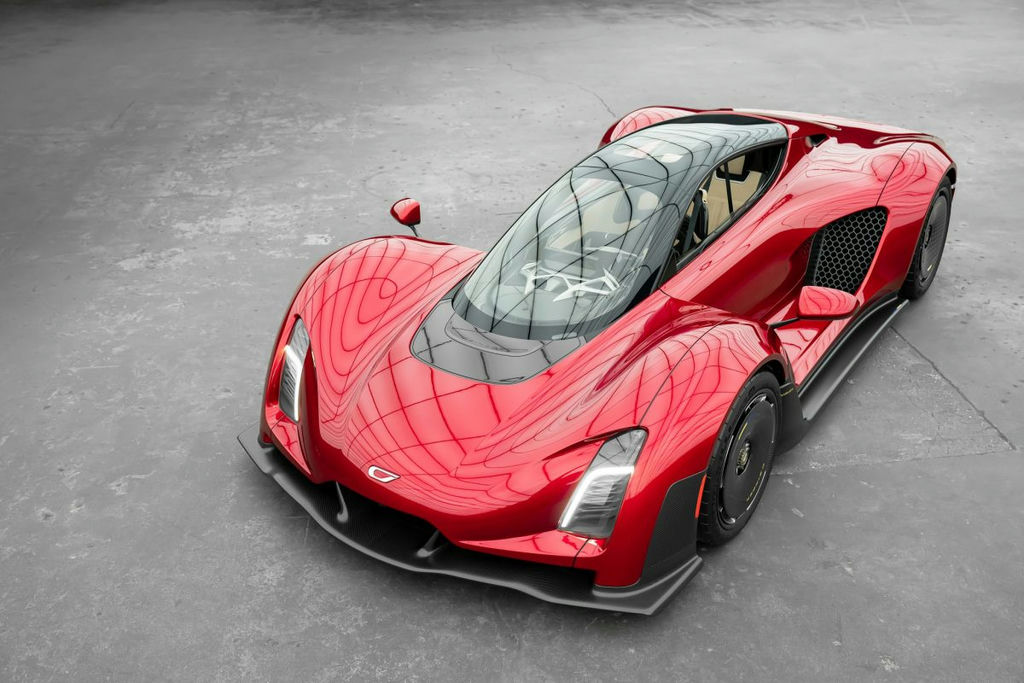Sculpted and perforated, Czinger’s BrakeNode looks lifted from an H.R. Giger sketchbook. But it’s not mere lunacy. There’s a method to this madness.
On the surface,the 1250-hp Czinger 21C is unlike anything else on the road. Its giant glass cockpit and gaping side intakes are more aeronautic than automotive. Under the skin, though, is where things get properly weird. Consider what Czinger calls the BrakeNode: It merges brake-caliper and suspension components into a single, oddly organic shape.
Sculpted and perforated, it looks lifted from an H.R. Giger sketchbook. But it’s not mere lunacy. There’s a method to this madness. “We are fully, functionally integrating the brake caliper and upright structures, which so far is on track to deliver over 40 percent mass and part-count reduction with 25 percent stiffness increase—no compromise and no tooling required,” explains Michael Kenworthy, CTO of AM Technologies at Divergent 3D, manufacturer of the Czinger 21C.
The BrakeNode and many of the 21C’s other components are manufactured using a process colloquially called 3D printing. Its formal name is additive manufacturing. “We literally make part geometries that cannot be economically produced any other way,” Kenworthy says.
Traditional manufacturing techniques like casting, milling, and stamping haven’t changed much since the First Industrial Revolution. Three-dimensional printing is wholly new, an umbrella term for a variety of techniques for creating physical objects from digital designs on a layer-by-layer approach. The concept dates to Forties science fiction and saw its first practical implementations in the Eighties. Really, though, it’s only in the past 20 years that the technology has matured to usefulness.

A typical $300 home 3D printer uses one of two techniques. Fused deposition modeling is the more common one. These printers force spools of plastic filament through heated nozzles, like a hot glue gun. The filament then hardens as it cools, constructing parts layer by layer. The other technology is stereolithography, where UV light hardens resin a layer at a time.
These simple, cheap techniques produce some great-looking parts. However, at the production-automotive level, finer tolerances and greater durability are necessities. So most pros turn to powder bed fusion. These machines can cost upwards of $500,000 and form parts by bonding powdered materials.
“We primarily employ laser powder bed fusion, which involves layer-by-layer, selective laser melting of atomized metal powders,” Kenworthy says. “We are generally printing with layer thicknesses on the order of human hairs, around 50 to 100 micron.”
That’s fittingly exotic, but it has mainstream applications too. In 2021, General Motors had 30,000 Chevrolet Tahoes sitting idle due to a single missing component. Traditional production tooling for a new part would have taken months, even if it were possible amid the pandemic. But GM whipped up the parts on the fly using 3D printing, and the SUVs got to dealerships.

GM’s first production 3D-printed parts were a little more specialized. “The Cadillac CT4-V Blackwing and CT5-V Blackwing were GM’s first production vehicles with printed parts, including the shift-knob emblem, an electrical harness bracket, and two HVAC ducts. Additive manufacturing also contributed to cost [savings] and efficiency in developing the manual transmission, so you could say manual Cadillacs are around because we have this capability,” explains Brennon White, technical lead for GM Additive Manufacturing.
And there’s more to come. The Cadillac Celestiq won’t only be the brand’s first electric flagship sedan. “We expect it to showcase the broadest use of additive manufacturing in a production vehicle, with more than 100 3D-printed parts that are a mix of structural and visual components,” White says. “This number of parts was made possible by expanding on the learnings from the Blackwing programs.”

PETER LARSON
Then there’s racing. Brad Keselowski, the 2012 NASCAR Cup champion, has a side gig: Keselowski Advanced Manufacturing (KAM), an engineering company focusing on additive manufacturing and parts simulation. “Additive manufacturing is an engineer’s dream tool, because 3D-printing technology allows us to manufacture part geometries that were never possible before using traditional machining, brazing, and welding techniques,” says Keselowski.
Keselowski saw his first 3D-printed component, a plastic intake manifold on a race car, at age 15. While KAM focuses on aerospace projects, like printing rocket-engine parts, the company has also printed parts for his No. 6 RFK Mustang GT. “Most recently we’ve manufactured a power-steering reservoir with enhanced design and found improved performance at a lighter weight,” he says. “Better yet, we reduced the lead-time development by leveraging rapid iteration for the reservoir design and testing.
“These outcomes are truly stunning,” Keselowski says, “and it’s deeply inspiring to be a part of today’s American manufacturing in the Fourth Industrial Revolution.” The best part is that the industry is still discovering what’s possible. In a few years, even the 21C could look bland.
This story originally appeared in Volume 14 of Road & Track.
Subscribe to AM Chronicle Newsletter to stay connected: https://bit.ly/3fBZ1mP
Follow us on LinkedIn: https://bit.ly/3IjhrFq
Visit for more interesting content on additive manufacturing: https://amchronicle.com


